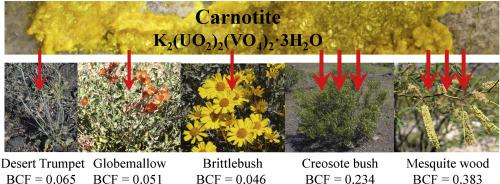Journal of Environmental Radioactivity ( IF 1.9 ) Pub Date : 2020-05-16 , DOI: 10.1016/j.jenvrad.2020.106293 Rachel Wetle 1 , Beatrice Bensko-Tarsitano 1 , Kyle Johnson 1 , Ken G Sweat 1 , Thomas Cahill 1

|
This research assessed a variety of native desert plant species for their ability to accumulate toxic elements in an abandoned uranium mine in the Sonoran Desert. Paired soil and plant samples were collected for six species of plants that had naturally re-colonized the mine. The mine soils had a median uranium concentration of 56.0 mg kg−1 (range: MDL to 696) while the plant samples had concentrations of 3.7 mg kg−1 (range: MDL to 20.0). The results showed uranium bioconcentration factors (BCFs) were between 0.051 and 0.234 with the longer-living, woody species having higher concentrations than short-lived herbaceous species. These BCF values were near the high end of values reported in the literature which implies that these desert species were either better at acquiring elements or they have fewer mechanisms to eliminate elements (e.g. litterfall). The life histories of the species were then evaluated on four criteria, namely uranium BCF, inedibility, longevity, and root depth, to assess which species would be best for phytostabilization, which is the use of plants to stabilize the soil to prevent water or wind erosion that might transport contaminants off site. The goal was to select a species that would stabilize the soil without accumulating uranium in the above ground biomass where it could enter the food web and be transported off site. Ultimately, brittlebush (Encelia farinosa A. Gray ex Torr.) was selected because of its low BCF, shallow roots and reasonable longevity.
中文翻译:

废弃铀矿中沙漠植物中的铀吸收及其对植物稳定策略的影响。
这项研究评估了各种本地沙漠植物物种在Sonoran沙漠中一个废弃铀矿中积累有毒元素的能力。收集了六种自然地重新定居了该矿的植物的成对土壤和植物样本。矿土壤的铀中位数浓度为56.0 mg kg -1(范围:MDL至696),而植物样品的铀浓度中值为3.7 mg kg -1(范围:MDL至20.0)。结果表明,铀的生物富集系数(BCFs)在0.051到0.234之间,寿命更长的木本物种的浓度高于短命的草本物种。这些BCF值接近文献报道的高端值,这意味着这些荒漠物种要么更擅长获取元素,要么消除元素的机制更少(例如凋落物)。然后根据铀BCF,不育性,寿命和根深四个标准评估该物种的生活史,以评估哪种物种最适合植物稳定化,即使用植物稳定土壤以防止水或风可能将污染物运离现场的侵蚀。目的是选择一种能够稳定土壤而不使铀在地上生物量中积累的物种,在那里铀可以进入食物网并被异地运输。最终,brittlebush(选择Encelia farinosa A. Gray ex Torr。是因为它的BCF低,根系浅且寿命长。











































 京公网安备 11010802027423号
京公网安备 11010802027423号